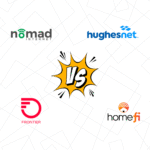Choosing the right wireless home internet isn’t just about speed anymore. It’s about flexibility, coverage, value for money, and how easily you can get connected without dealing with cables or lengthy installations. Whether you’re living in a busy city, a small town, or somewhere off the beaten path, Nomad, HomeFi, and Verizon 5G all bring their own strengths to the table.
This in-depth guide breaks down what each provider offers so you can decide which one fits your lifestyle best.
Quick Overview:
Wireless home internet has become a game-changer for people who want simple setup, mobility, and the ability to stay connected wherever they are. These providers use different approaches, from nationwide cellular networks to custom hardware setups, making it easier than ever to get online without traditional wiring.
Here’s how the main contenders compare:
Key Feature Comparison:
| Feature | Nomad | HomeFi | Verizon 5G Home |
|---|---|---|---|
| Top Speed | Up to 200 Mbps | Up to 300 Mbps | Up to 1 Gbps |
| Data Caps | No | No | No |
| Equipment | Included router | Included gateway | Included router |
| Installation | Self-install | Self-install | Self-install |
| Coverage Type | Nationwide LTE/5G | 4G LTE & 5G | 5G Ultra Wideband & LTE |
| Notable Perks | Portable, works on-the-go | Stable speeds, home-focused setup | Super-fast in 5G zones |
Performance & Reliability:
- Nomad thrives on portability. You can take it anywhere there’s LTE or 5G coverage, making it perfect for RVs, travelers, and renters. Speeds depend heavily on local network strength but generally remain stable in well-covered areas.
- HomeFi is designed for stationary home use. It focuses on delivering consistent speeds, even in areas where wired internet isn’t available. It can handle multiple devices at once without major slowdowns.
- Verizon 5G Home is the powerhouse in strong 5G coverage zones. Ultra-low latency and gigabit-level speeds make it ideal for streaming, gaming, and heavy data usage, but performance can drop in LTE fallback areas.
Plans & Pricing:
| Plan Type | Nomad | HomeFi | Verizon 5G Home |
|---|---|---|---|
| Standard | $99/mo | $99/mo | $50–$70/mo (with mobile discount) |
| Higher-Tier / Unlimited | Same flat rate | Same flat rate | $70/mo (no mobile discount) |
| Installation | Free | Free | Free |
| Equipment | Included | Included | Included |
Pros & Cons:
| Provider | Pros | Cons |
|---|---|---|
| Nomad | True portability, works nationwide, no contracts | Speed can vary in congested areas |
| HomeFi | Reliable for rural or suburban homes, easy setup | Less portable than Nomad |
| Verizon 5G | Fastest speeds where 5G is strong, low latency | Coverage not as strong in remote areas |
Who Should Choose What?
- Go with Nomad if you need an internet option you can take anywhere and don’t want to be tied down to one address.
- Pick HomeFi if you want a stable, wireless solution that stays put and works well for households without wired internet access.
- Choose Verizon 5G Home if you live in a strong 5G coverage area and want blazing-fast speeds for streaming, gaming, and large downloads.
Customer Experience:
- Nomad customers like the no-commitment, take-it-anywhere style, especially for road trips or temporary stays.
- HomeFi users appreciate the steady connection and ease of setup without needing a technician.
- Verizon 5G Home earns praise for speed and competitive pricing, but some note that coverage can be hit-or-miss in certain locations.
FAQ: Wireless Home Internet
Question 1. Does Nomad, HomeFi, or Verizon 5G work anywhere?
Answer: Nomad offers coverage anywhere LTE or 5G service is available in the U.S. HomeFi and Verizon 5G Home provide service across wide areas through their respective networks.
Question 2. Do Nomad, HomeFi, or Verizon 5G require contracts?
Answer: Nomad and HomeFi are available with simple month-to-month plans. Verizon 5G Home also offers flexible, contract-free options, with special deals for eligible customers.
Question 3. Is equipment included with Nomad, HomeFi, or Verizon 5G?
Answer: Yes. Each provider includes the necessary router or gateway as part of the plan, so you can get connected right away.
Question 4. Can I use Nomad, HomeFi, or Verizon 5G for gaming?
Answer: Yes. All three providers deliver fast and responsive connections suitable for online gaming.
Question 5. Can I take Nomad, HomeFi, or Verizon 5G on the road?
Answer: Nomad is designed to be portable and works in multiple locations. HomeFi and Verizon 5G Home are ideal for setting up a dependable connection at your primary residence.
Question 6. How many devices can connect to Nomad, HomeFi, or Verizon 5G at the same time?
Answer: Each provider supports multiple connected devices, making it easy for households to stream, work, and browse at the same time.
Question 7. Does weather impact Nomad, HomeFi, or Verizon 5G?
Answer: All three providers are built to perform reliably in a variety of weather conditions, using advanced network technology to keep you connected.
Question 8. Do Nomad, HomeFi, or Verizon 5G have data limits?
Answer: All three providers offer unlimited data plans, giving you the freedom to browse, stream, and work without worrying about usage caps.
Final Thoughts:
Nomad, HomeFi, and Verizon 5G each have their own edge. Nomad wins for travel-friendly flexibility. HomeFi delivers steady, home-focused performance in areas with limited wired options. Verizon 5G Home is unbeatable for speed in the right location.
Your choice should come down to where you live, how you plan to use the service, and whether mobility or maximum performance matters most to you.


